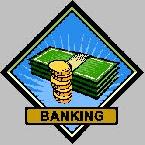
 |
|
| Financial Terms | |
| kanban |
|
Information about financial, finance, business, accounting, payroll, inventory, investment, money, inventory control, stock trading, financial advisor, tax advisor, credit.
Main Page: tax advisor, inventory control, financial advisor, stock trading, credit, investment, money, inventory, |
Definition of kanban
kanbanthe Japanese word for card; it was the original name
Related Terms:economic components modelAbrams’ model for calculating DLOM based on the interaction of discounts from four economic components. Accelerated cost recovery system (ACRS)Schedule of depreciation rates allowed for tax purposes. Additional hedgeA protection against borrower fallout risk in the mortgage pipeline. Automated Clearing House (ACH)A collection of 32 regional electronic interbank networks used to Block houseBrokerage firms that help to find potential buyers or sellers of large block trades. CARDsCertificates of Amortized Revolving Debt. Pass-through securities backed by credit card receivables. Clearing House Automated Payments System (CHAPS)A computerized clearing system for sterling funds  Clearing House Interbank Payments System (CHIPS)An international wire transfer system for high-value Clearing house / ClearinghouseAn adjunct to a futures exchange through which transactions executed its floor are settled by a Commission houseA firm which buys and sells future contracts for customer accounts. Related: futures Commodities Exchange Center (CEC)The location of five New York futures exchanges: Commodity Corporate processing floatThe time that elapses between receipt of payment from a customer and the Diffusion processA conception of the way a stock's price changes that assumes that the price takes on all Dupont system of financial controlHighlights the fact that return on assets (ROA) can be expressed in terms European Monetary System (EMS)An exchange arrangement formed in 1979 that involves the currencies Federal Reserve SystemThe central bank of the U.S., established in 1913, and governed by the Federal  Field warehouseWarehouse rented by a warehouse company on another firm's premises. Imputation tax systemArrangement by which investors who receive a dividend also receive a tax credit for Indicated dividendTotal amount of dividends that would be paid on a share of stock over the next 12 months Indicated yieldThe yield, based on the most recent quarterly rate times four. To determine the yield, divide Inflation-escalator clauseA clause in a contract providing for increases or decreases in inflation based on In-house processing floatRefers to the time it takes the receiver of a check to process the payment and Just-in-time inventory systemssystems that schedule materials/inventory to arrive exactly as they are Money center banksBanks that raise most of their funds from the domestic and international money markets, relying less on depositors for funds. Multicurrency clauseSuch a clause on a Euro loan permits the borrower to switch from one currency to Multirule systemA technical trading strategy that combines mechanical rules, such as the CRISMA Negative pledge clauseA bond covenant that requires the borrower to grant lenders a lien equivalent to any Net working capitalCurrent assets minus current liabilities. Often simply referred to as working capital. Nonsystematic riskNonmarket or firm-specific risk factors that can be eliminated by diversification. Also Original face valueThe principal amount of the mortgage as of its issue date. Original issue discount debt (OID debt)Debt that is initially offered at a price below par. Original marginThe margin needed to cover a specific new position. Related: Margin, security deposit (initial) Original maturityMaturity at issue. For example, a five year note has an original maturity of 5 years; one Price discovery processThe process of determining the prices of the assets in the marketplace through the Progressive tax systemA tax system wherein the average tax rate increases for some increases in income but Public warehouseWarehouse operated by an independent warehouse company on its own premises. Reinvoicing centerA central financial subsidiary used by an MNC to reduce transaction exposure by having Split-rate tax systemA tax system that taxes retained earnings at a higher rate than earnings that are Street nameDescribes securities held by a broker on behalf of a client but registered in the name of the Wall Street firm. Subordination clauseA provision in a bond indenture that restricts the issuer's future borrowing by SystematicCommon to all businesses. Systematic riskAlso called undiversifiable risk or market risk, the minimum level of risk that can be Systematic risk principleOnly the systematic portion of risk matters in large, well-diversified portfolios. Trade houseA firm which deals in actual commodities. Two-tier tax systemA method of taxation in which the income going to shareholders is taxed twice. Unsystematic riskAlso called the diversifiable risk or residual risk. The risk that is unique to a company Warehouse receiptEvidence that a firm owns goods stored in a warehouse. WashGains equal losses. Wasting assetAn asset which has a limited life and thus, decreases in value (depreciates) over time. Also Wild card optionThe right of the seller of a Treasury Bond futures contract to give notice of intent to deliver Wire houseA firm operating a private wire to its own branch offices or to other firms, commission houses or Working capitalDefined as the difference in current assets and current liabilities (excluding short-term Working capital managementThe management of current assets and current liabilities to maximize shortterm liquidity. Working capital ratioworking capital expressed as a percentage of sales. WorkoutInformal arrangement between a borrower and creditors. Workout periodRealignment period of a temporary misaligned yield relationship that sometimes occurs in MACRS (Modified Accelerated Cost Recovery System)A depreciation method created by the IRS under the Tax Reform Act of 1986. Companies must use it to depreciate all plant and equipment assets installed after December 31, 1986 (for tax purposes). Accounting systemA set of accounts that summarize the transactions of a business that have been recorded on source documents. Balanced ScorecardA system of non-financial performance measurement that links innovation, customer and process measures to financial performance. Planning, programming and budgeting system (PPBS)A method of budgeting in which budgets are allocated to projects or programmes rather than to responsibility centres. Process costingA method of costing for continuous manufacture in which costs for an accounting compared are compared with production for the same period to determine a cost per unit produced. Working capitalCurrent assets less current liabilities. Money that revolves in the business as part of the process of buying, making and selling goods and services, particularly in relation to debtors, creditors, inventory and bank. Work-in-progressGoods or services that have commenced the production process but are incomplete and unable to be sold. Additional paid-in capitalAmounts in excess of the par value or stated value that have been paid by the public to acquire stock in the company; synonymous with capital in excess of par. Periodic inventory systemAn inventory system in which the balance in the Inventory account is adjusted for the units sold only at the end of the period. Perpetual inventory systemAn inventory system in which the balance in the Inventory account is adjusted for the units sold each time a sale is made. Systematic RiskThe amount of total risk that cannot be eliminated by portfolio Unsystematic RiskThe amount of total risk that can be eliminated by diversification by activity centera segment of the production or service actual cost systema valuation method that uses actual direct balanced scorecard (BSC)an approach to performance business intelligence (BI) systema formal process for gathering and analyzing information and producing intelligence to meet decision making needs; requires information about business process reengineering (BPR)the process of combining information technology to create new and more effective charge-back systema system using transfer prices; see transfer computer-aided manufacturing (CAM)the use of computers to control production processes through numerically computer integrated manufacturing (CIM)the integration of two or more flexible manufacturing systems through the use of a host computer and an information networking system cost-benefit analysis the analytical process of comparing therelative costs and benefits that result from a specific course cost centera responsibility center in which the manager has cost control systema logical structure of formal and/or informal cost management system (CMS)a set of formal methods economically reworkedwhen the incremental revenue from the sale of reworked defective units is greater than enterprise resource planning (ERP) systema packaged software program that allows a company to FIFO method (of process costing)the method of cost assignment that computes an average cost per equivalent flexible manufacturing system (FMS)a production system in which a single factory manufactures numerous variations hybrid costing systema costing system combining characteristics investment centera responsibility center in which the manager JITsee just-in-time job order costing systema system of product costing used joint processa manufacturing process that simultaneously just-in-time (JIT)a philosophy about when to do something; just-in-time manufacturing systema production system that attempts to acquire components and produce inventory only as needed, to minimize product defects, and to management control system (MCS)an information system that helps managers gather information about actual organizational occurrences, make comparisons against plans, management information system (MIS)a structure of interrelated elements that collects, organizes, and communicates manufacturing cella linear or U-shaped production grouping of workers or machines manufacturing cycle efficiency (MCE)a ratio resulting from dividing the actual production time by total lead time; manufacturing resource planning (MRP II)a fully integrated materials requirement planning system that involves modified FIFO method (of process costing)the method of cost assignment that uses FIFO to compute a cost per multiprocess handlingthe ability of a worker to monitor network organizationa flexible organization structure that normal cost systema valuation method that uses actual Related to : financial, finance, business, accounting, payroll, inventory, investment, money, inventory control, stock trading, financial advisor, tax advisor, credit. |